The latest news on the Monarch Butterfly is cause for deep concern.
Surveys conducted this winter in the Mexican Highlands, where the bulk of the Monarch population overwinters, has revealed that the Monarch population dropped 15% from December 2016 to December 2017.
The population now occupies only 2.48 hectares (ha) of land. Since the counts were initiated, the greatest amount of land occupied was 18.19 ha. The current area of occupation represents a decline of almost 90% since the highest count in 1996. The figure below provides details of the overwintering counts.
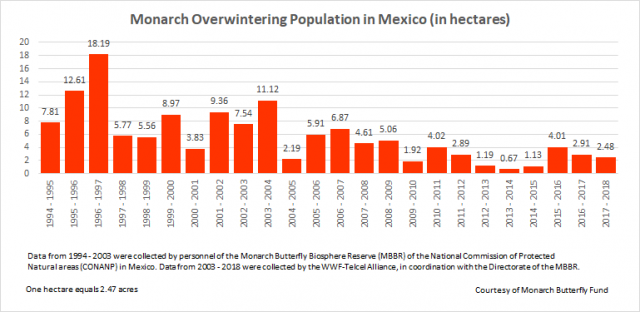
Why are Monarchs Declining?
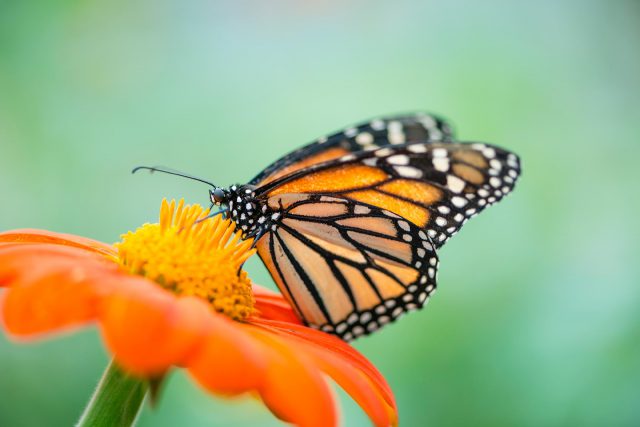
Scientists have listed the main cause of the decline to include habitat destruction on both breeding and wintering habitat. Also, use of pesticides and herbicides on agricultural lands, and climate change impacts have hurt this species. More recent research in the U.S. points the finger at yet another issue: diminished sources of nectar-rich plants along the migratory pathway. Nectar is the fuel that Monarchs need on their incredible journey from Canada to their overwintering grounds. Monarchs need to refuel regularly. The loss of nectaring wildflowers along their migratory path makes it hard for Monarchs to restore their depleted energy reserves. It would be similar to the removal of about one half of all gas stations along our vacation route. We would have difficulty refueling and might run out of gas.
Why did the Monarch Population Decline this Year?
Many of you rejoiced last summer when you saw many adult Monarchs flying in southern Canada. It seemed to be a banner year, especially in Ontario and Quebec. Here at the Canadian Wildlife Federation, we held hope that this would be a recovery year. So what happened to the population? One of the main culprits was the fall hurricanes that struck the southern U.S. this fall. Another culprit was the warmer than usual weather, which delayed migration in some parts of Canada and the United States. Both may have also contributed to reduced numbers in 2017.
Climate change brings extreme weather and increasing variability in weather. Climate change scientists predict increasing extreme weather events and more variability of weather. This will not likely be an advantage for the struggling Monarch population.
What is Being Done About the Decline?
The Committee on the Status of Endangered Wildlife in Canada (COSEWIC), which is tasked with assessing species and recommending listing to the federal government, has recommended that the Monarch be listed as Endangered under the federal Species at Risk Act. In Ontario, the Committee on the Status of Species at Risk in Ontario (COSSARO), the group of experts tasked with listing species under the province’s Endangered Species Act, will likely decide this year whether to list the Monarch as Endangered. An endangered listing will spark the creation of a Recovery Strategy with specific conservation action plans.
In addition to government action, there is plenty of good science happening for Monarchs. Maxim Larrivée’s team at the Montreal Insectarium and colleagues are researching whether milkweed is limited in Canada. Milkweed is the host plant that Monarch larvae depend on for survival, and there are several species of Milkweed in Canada. The results of this research will help us to understand the impact of changing land use on Monarch as well as whether we should target restoration of milkweed host plants to aid the recovery of Monarch.
On other science news, a Canadian study led by Tyler Flockhart determined that habitat in Canada contributed a relatively high proportion of the overwintering Monarchs in Mexico, considering Canada comprises a small portion of the total range of Monarch. The research team looked at chemical isotope signatures from Monarchs on the overwintering habitat to determine where the butterflies were born in the previous summer and fall. They found that 12 per cent of the insects were born in the northwestern U.S. and Canadian Prairies, 17 per cent in the north-central States and Ontario, 15 per cent in the northeastern U.S. and the Canadian Maritimes.
What is CWF Doing for the Monarch?
It will take large scale restoration efforts to increase breeding and nectaring habitat. The Canadian Wildlife Federation is forming partnerships with right-of-way corridor (e.g. roadways and hydro-electric) managers to conduct habitat restoration trials, including:
We aim to document the cost and conservation benefits of restoring Monarch habitat, which will inform restoration practices at a large landscape scale.
CWF also continues to engage school groups and citizens like you to plant milkweed and native wildflowers to provide for Monarch during breeding and migration. Everyone can help to restore Monarch habitat!
Let’s Do More for the Monarch!
 To compensate for ever increasing impacts of climate change and agricultural intensification, habitat restoration throughout breeding and overwintering habitat will need to overachieve conservation outcomes. In other words, restoration efforts will have to be bigger and better than ever before. It will take a concerted effort of federal, provincial, federal governments as well as private landowners to make this happen. Together, we have to knock it out of the park for the Monarch!
To compensate for ever increasing impacts of climate change and agricultural intensification, habitat restoration throughout breeding and overwintering habitat will need to overachieve conservation outcomes. In other words, restoration efforts will have to be bigger and better than ever before. It will take a concerted effort of federal, provincial, federal governments as well as private landowners to make this happen. Together, we have to knock it out of the park for the Monarch!

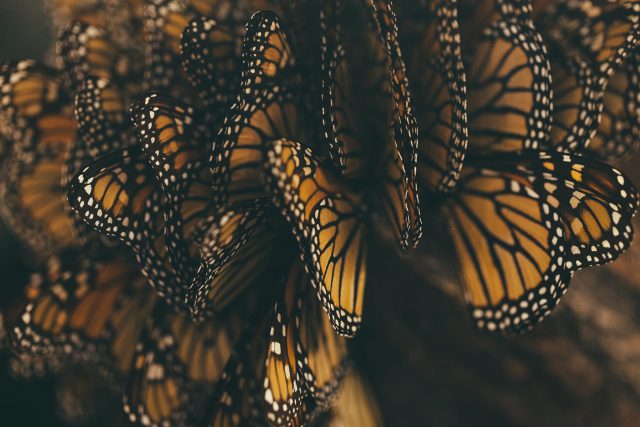
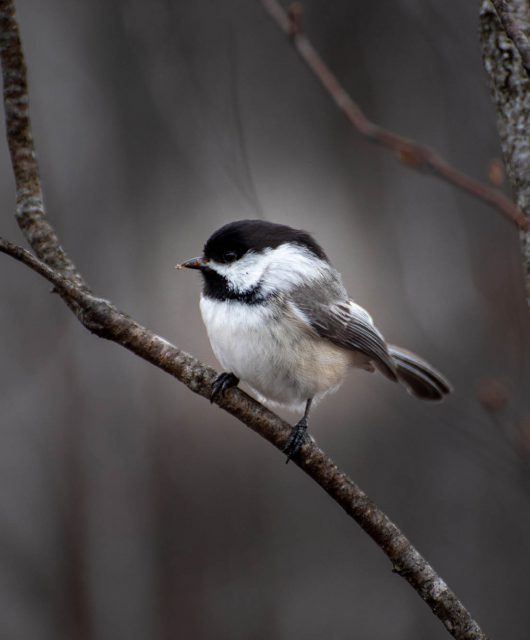

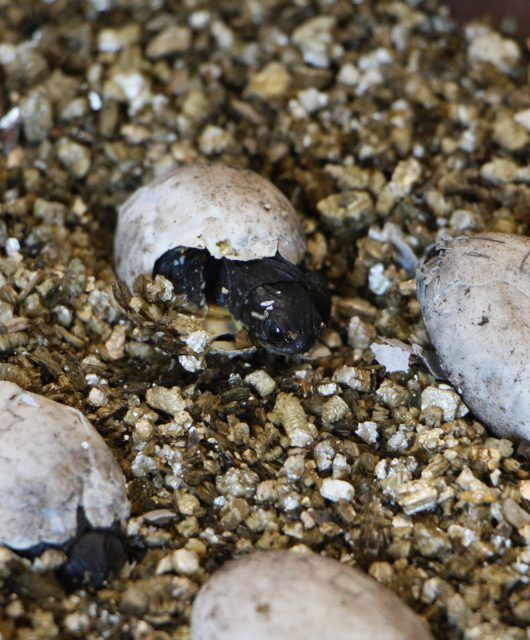
6 comments
I recall this summer that I was surprised to see many more Monarch butterflies in northern BC (Smithers, BC) and then learned there were very few in the southern states which was very unusual. However, this was not the only strange happening in Smithers last summer. We were inundated with silk moths which covered the town both on walls of buildings and all over the ground throughout the whole town. Then very tiny insects would be found on my stovetop every morning when I got up upside down with their teeny weeny feet sticking up, all dead. Another strange entomology event were very fine cobwebs everywhere in the house. I was told by my husband that they were made by Daddy-Longlegs (don’t know entomology name for them). All these strange things were happening at once. The fact that the south was without their Monarchs and we in the north had them seemed to trigger a very strange summer. Something had obviously changed, but what?
We want to help save the monarch butterflie’s
how can we help?
From: Ady, Lydie, and Teagan
Hi Ady, Lydie and Teagan!
Thank you for your interest in the Monarch Butterfly! There is loads you can do, especially in your own back (or school) yard:
Learn more about Gardening for Wildlife or creating WILD Spaces at schools!
Why do monarch butterfly’s huddle together when they are on trees?
Hello
It is to keep warm and likely also to reduce individual risk of predation. This behaviour is only exhibited by the super generation – the one that migrates to Mexico. They roost during migration and during the winter in Mexico.
Thanks!
There is a 15 acre field behind my property. There is an abundance of milkweed but I rarely see a butterfly. I wonder why.